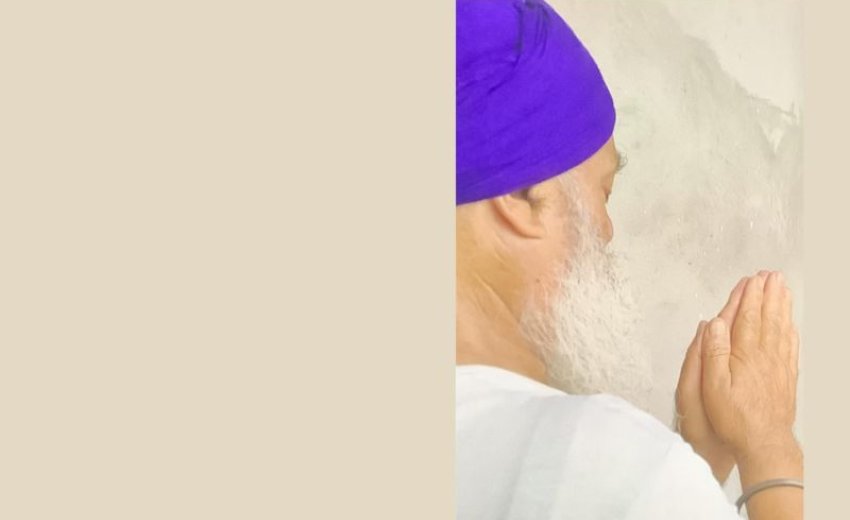Abstract:
Ardaas, a sacred supplicatory prayer in Sikhism, holds immense spiritual and communal importance. This study examines the traditional structure, prescriptive discipline, and the evolving forms of Ardaas as observed in contemporary Gurdwaras and Sikh practices. It assesses how deviations from its original format—through personalized additions and lengthened recitations—pose challenges to its sanctity and effectiveness. Drawing upon the Sikh Rehat Maryada and Gurbani references, this paper underscores the theological, ritualistic, and communal implications of such changes, while also reflecting on the diverse expressions of reverence during Ardaas through physical gestures such as folding hands.
Introduction
In Sikh religious life, Ardaas (prayer) is a sacred and structured spiritual act performed at the beginning or conclusion of nearly every religious service—be it recitation of scriptures, congregational singing (Kirtan), or community meals (Langar). The original form of Ardaas is attributed to Bhai Sahib Bhai Giani Gian Singh Ji. Over time, it has become an integral part of Sikh daily praxis, imbued with both historical consciousness and personal devotion.
The Tripartite Structure of Ardaas
Traditionally, the Ardaas is composed of three primary segments:
- From “Ik Oankar Waheguru Ji Ki Fateh…” to “Dassan Patshahiyan di Jot…”—a fixed, inviolable opening invoking the divine and the lineage of the Ten Gurus.
- A historical section, recalling the sacrifices and struggles within Sikh history, such as references to Bandi Chhor, martyrs, massacres (Ghallugharas), and the liberators (Muktay).
- The concluding segment, which accommodates individual or collective petitions, such as:
- Prayers for universal welfare (Sarbat da Bhala)
- Blessings for good leadership
- Supplications relevant to particular rites or gatherings.
Expansion of Ardaas in Contemporary Practice
In many modern Gurdwaras, a trend has emerged where the standard format of Ardaas is extended with:
- Detailed descriptions of events or individuals.
- Personal intercessions (e.g., “grant long life to such a family” or “bless Bhai Jarnail Singh with a job” etc ).
- Overly descriptive elaboration of minor details.
These additions often extend the prayer’s duration from the traditional 3 minutes to 7–10 minutes, which can lead to discomfort among elderly devotees and mothers in the congregation.
The Normative Framework: Sikh Rehat Maryada
The Sikh Rehat Maryada provides unambiguous guidelines regarding Ardaas. According to it:
- The fundamental structure of Ardaas must remain uniform.
- Personalized petitions, if any, should be brief and in alignment with Gurmat (the Guru’s teachings).
- The sanctity of the prayer should not be compromised for personal glorification or unnecessary elaboration.
Potential Drawbacks of Deviations
- Distraction: Overextended and personalized Ardaas often disrupts the spiritual focus of the congregation.
- Deviation from Tradition: It undermines the codified spiritual heritage outlined in the Rehat Maryada.
- Disrespect of Time: The elongation of Ardaas can delay subsequent spiritual activities like Kirtan or Langar.
Recommendations for Completeness with Brevity
This critique does not advocate for a shortened Ardaas but emphasizes conciseness, discipline, and spiritual concentration. Personal supplications, if included, should be:
- Brief and relevant
- Consistent with Sikh theology
- Free from self-promotion or mundane elaboration
Varied Postures of Devotion During Ardaas in Gurdwaras
Ardaas also finds its expression in various physical gestures among the congregants, each bearing spiritual and cultural significance:
1. Traditional Folding of Hands
The most common and scripturally supported posture involves bringing both palms together before the chest—symbolizing surrender of the mind, intellect, and heart to the Divine. As Guru Granth Sahib states:
“Haath jor binantee karee jee-o…”(Sri Guru Granth Sahib, Ang 682)
This gesture signifies spiritual humility and earnest prayer.
2. Hands Raised to the Forehead or Overhead
Some devotees raise their folded hands to the forehead or above the head during Ardaas—a symbolic act of deep reverence and spiritual surrender rooted in older traditions. While it may be culturally expressive, it denotes fervent emotional devotion.
3. Fingers Interlaced or Held Low
In recent times, some individuals cross their fingers or loosely clasp hands at the belly, which can appear irreverent. Such practices should be discouraged through awareness and spiritual education.
4. Eyes Closed with Folded Hands
This expression denotes inner focus and meditative connection with the Divine. Guru Granth Sahib emphasizes such detachment:
“Aap chhod seva karai taa kichh milai thaai.” (Ang 286)
5. Children or Newcomers with Open or Idle Hands
Often observed among those unfamiliar with Sikh discipline, such gestures are not violations but opportunities for spiritual education. Gurdwaras should gently instruct them on appropriate devotional conduct.
The Core Message: Humility and Surrender
Ultimately, the external form of hand-folding is secondary to the inner state of devotion and humility. As Guru Amar Das Ji affirms:
“Manu nivai maatha nivai nivai sadaa humai maarai.” (Ang 730)
Thus, Ardaas is a profound spiritual dialogue—between the devotee and the Timeless Guru—not meant to be diluted by worldly embellishments. We must strive to preserve its sanctity, discipline, and spiritual intensity in line with Gurmat. The diversity in outward postures is acceptable, but all must root in surrender, faith, and devotional purity.

